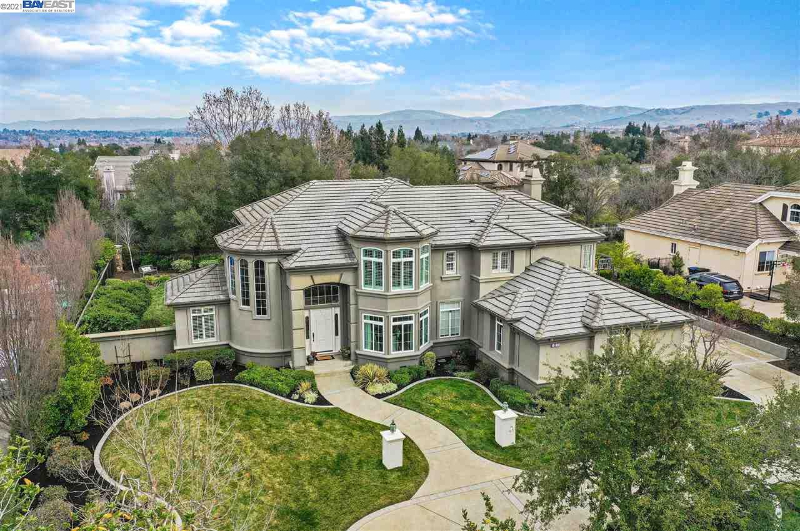
The Bay Area is probably one of the most highly sought-after places for living in the continental United States, primarily for its reputation as a tourism, technology, and cultural hub. More so in San Francisco and Silicon Valley – two of the most notable urban spaces in the Bay Area whose names immediately evoke images of the Golden Gate Bridge, cable cars, and the Google brand. It is this popularity that has also made them two of the hottest places for real estate. That said, home values here are way off the charts and so is the cost of living.
Fortunately, there are other places in the Bay Area where people can get the best quality of life comparable to San Francisco and Silicon Valley but at a more affordable price. One such place is the City of Pleasanton.
Located across San Francisco Bay on the East Bay side is Pleasanton, CA – dubbed by Niche.com as one of the best Bay Area suburbs to live in. In this lovely city in Alameda County, you’ll find the perfect balance between a small-town vibe and urban dynamism.
To learn more about Pleasanton, CA, the lifestyle, and the homes for sale in the area, our team at Venema Homes put together some of the most frequently asked questions and other interesting facts about this remarkable suburb below.
MOST FREQUENTLY ASKED QUESTIONS ABOUT BUYING A HOME IN PLEASANTON, CA

How are housing market trends in Pleasanton?
The previous year saw home values peaking at a median price of $1.9 million, particularly in the summer months. The real estate market in Pleasanton has stabilized since then but remains extremely competitive, meaning that most listed properties continue to get multiple offers and go off the market fairly quickly. As of January 2023, homes were sold at a median price of $1.5 million, lower than the previous year’s $1.56 million. Homes for sale in Pleasanton CA have a price range from $175,000 to as high as almost $11 million.
While home prices in Pleasanton remain at stratospheric levels, it’s taking almost twice the time for available homes to be taken off the market compared to last year. Homes for sale in Pleasanton, CA stayed for an average of 60 days in the market in January 2023, compared to the previous year’s 39 days.
The latest figures from Statista.com (3Q, 2022) put the national median home price at $392,000. The January 2023 median price of homes in Pleasanton, CA is almost four times higher than the national median. Zumper.com, for its part, recorded the national average rent for a two-bedroom residence at $1,822. In comparison, the average rent for residences in Pleasanton was $4,937 – almost three times higher than the national average.
In terms of homeownership, more than half of Pleasanton’s population (67.6%) own the residences they live in. Renters constitute 32.4% of the population, while 4.3% of homes in this suburb are vacant.
Is it a buyer’s or seller’s market?
As of January 2023, the housing market in Pleasanton, CA is a seller’s market, according to data from Realtor.com. In fact, the entire Bay Area is a seller’s market. Generally, this means that homes and other forms of real estate are in demand. But how does this distinction affect you as a home buyer?
The difference between buyer’s and seller’s markets
A buyer’s market is when the number of properties for sale in an area exceeds the demand. It can also be interpreted as a shortage of interested home buyers in the area. In this case, buyers are at an advantage over sellers because they have more bargaining power. Sellers are forced to compete with each other by keeping real estate prices down so they can attract more potential buyers. This may also mean that homes stay on the market for a longer time than average.
Meanwhile, a seller’s market occurs when the demand for real property is higher than the supply. There are fewer homes to go around, so the sellers are the ones at an advantage. Properties sell faster and buyers are willing to compete with each other in fierce bidding wars.
You can determine if a place is a buyer’s or seller’s market by checking the inventory, recent sales figures, pricing trends, the average time a property stays on the market, and the market trends of a particular area over time.
What are the available property types in the city?
Pleasanton is filled with almost every type of property from single-family homes to whole stretches of raw land. The most common of them all is the single-family home, and these come in every shape, size, and price. Most single-family homes here have four bedrooms but you can still find smaller ones and studio types. That said, Pleasanton has just the kind of home for every type of lifestyle and budget.
High-end single-family homes have more bedrooms and baths and often have multi-car garages, private entrances, a chef’s kitchen, a butler’s pantry, formal dining rooms, a ground pool, an in-house spa, a waterfall, and several patios. You can also find homes with up to 7,000 square feet of living space. Some luxury estates may even have an au pair room, in-law quarters, office, den, atrium, and more.
Also found in abundance in Pleasanton are townhomes and sturdy mobile homes that could make for fantastic starter homes, especially among those buying real estate for the first time.
What are the popular architectural styles in Pleasanton?

CAPTION. A lovely Queen Anne-style luxury home, typical of Pleasanton’s love affair with Victorian-era architectural influences.)
Pleasanton is known for its rich history and diversity, and this reflects in the homes that you see here, as well as in the rest of Alameda County. Most noticeable is the dominance of Victorian-style homes and the overt attempt of the more straightforward Craftsman homes to exert their presence in the Pleasanton landscape.
Under the ornate Victorian styles are Queen Anne, Shingle, and Stick – but the most popular among these in Alameda County is the Queen Anne style. You can see this particular design among homes with steep and ornate roofs and curvilinear turrets and towers.
As an antithesis to the highly decorative Victorian home designs, Pleasanton builders began designing homes in the practical and sturdy Craftsman style. This particular design came about at the time of the Great Depression when austerity was the order of the day. However, one cannot deny the simple but attractive features of a Craftsman home: a covered porch supported by columns, overhanging eaves, low-pitched gable roofs, and a fireplace.
Other popular architectural styles found in Pleasanton are:
- Colonial Revival
- Mediterranean
- Tudor / Tudor Revival
- Mid-century Modern
- Ranch
What are the best neighborhoods in Pleasanton?
Overall, Niche.com describes Pleasanton as having a sparse urban to suburban vibe. Still, each of its neighborhoods evokes its own kind of charm and character. Should you decide to move to Pleasanton, CA, this list will give you a glimpse into some of its best neighborhoods:
- DOWNTOWN PLEASANTON. If you’re looking for a neighborhood that’s close to your workplace, you can’t go wrong with Downtown Pleasanton. It’s a highly diverse and urban space so you can expect a vibrant commercial district, along with the largest concentration of retail and dining hubs here. Homes in and around the downtown area tend to be smaller, though, with a good number of these being rented out. However, their proximity to the epicenter of commerce in the city makes them among the most highly sought-after and, ultimately, properties with a high price tag.
- LAS POSITAS GARDENS.A dense urban neighborhood lined with rows of houses – this is how to best describe Las Positas Gardens. Niche.com gives this community the top rank among all of Pleasanton’s neighborhoods. Apart from being an ideal place for young professionals and growing families to live in Pleasanton, the area is also home to a large Asian community, with a spattering of residents with Irish, Mexican, English, and German ancestry.
- STONERIDGE PARK. Considered one of Pleasanton’s more affluent neighborhoods, Stoneridge Park is replete with some of the grandest estates in the city. However, despite the presumed wealth of its residents, a good number of them prefer riding the train to work instead of withstanding around an hour of driving through traffic. The neighborhood profile is quite diverse, it won’t be hard to fit in even if you come from outside the country. Also located in the neighborhood is Henry P. Mohr Elementary School, right next to Amaral Park.
- VINTAGE HILLS.A fairly recent development, Vintage Hills has properties mostly built from the 70s down to just before the turn of the millennium. Many of Pleasanton’s elite have properties here. These are people with jobs in management or executive positions. It’s also one of the best places to raise a family in Pleasanton and is close to many of the local schools in the area.
What do I need to prepare before purchasing property in Pleasanton, CA?

First, get your finances in order. How much have you saved up for the downpayment? Will you need financing and if so, how much will you borrow from the bank? What’s the mortgage rate in the area? Make sure also that you have a good credit score to qualify for most mortgages and to get the best terms possible.
Second, you’ll need to work with an expert real estate professional, preferably one who knows Pleasanton and its surrounding areas. This agent can help you make sound offers, negotiate, and close on your new home – among many other tedious tasks that may have otherwise fallen on your shoulders. They can also walk you through the process and help you get the paperwork in order so you can maximize your time and your experience purchasing property in Pleasanton, CA.
FAQs ABOUT LIVING IN PLEASANTON, CA
The pricing of homes for sale in Pleasanton, CA and the real estate market stats of this San Francisco suburb don’t exactly encapsulate the kind of lifestyle you can expect once you finally move here. To give you a better idea of what’s in store for you here, we compiled some of the most frequently asked questions about Pleasanton, CA.
Why is it called Pleasanton?
Pleasanton’s name was chosen by John W. Kottinger, an Alameda County justice of the peace, after his close friend, Union Army Cavalry Major General Alfred Pleasonton. A recording clerk in Washington D.C. made a typographical error that resulted in the city’s present-day spelling.
What’s it like to live in Pleasanton, CA?
According to Niche.com, Pleasanton is the 15th best suburb to live in in the San Francisco Bay Area. It’s also the 19th out of 524 suburbs with the best public schools in California and is one of the best suburbs to raise a family in California. The website also gives a high overall popularity score to the city for its great public schools, safe environment, nightlife, and diversity.
According to resident reviews, the city has plenty of amazing people, a great community, and low crime rates. There are also plenty of opportunities for recreation and other outdoor activities.
What’s the area’s demographic profile?
2021 figures from the U.S. Census Bureau place Pleasanton, CA’s population at more than 78,000. A majority of the population is in the workforce while seniors comprise about 14% of the local population. More than half (66.3%) of the population above 25 years old possess a bachelor’s degree or higher.
A wide range of ethnicities has been identified among Pleasanton’s residents – thus, its reputation as a richly diverse suburb. The representation includes White, Black, Asian, Pacific Islander, and Hispanic residents.
How is Pleasanton’s economy?
Pleasanton is also known for its abundance of job opportunities and businesses. The median household income in the area is $167,923, which is more than twice the national average of $69,021. The top employers in the area include Safeway, The Vons Companies, Inc., Natus Medical, Spotless, Workday, and Cooper Companies.
How can I get around in Pleasanton, CA?
Despite Pleasanton being a car-friendly city, it also has many options for getting from Point A to Point B via public commute. It also helps that there are two major highways running north to south (Route 680 to the west of the city) and east to west (Route 580 to the north of the city).
The most commonly used public transit in the city is BART or the Bay Area Rapid Transit, which connects the San Francisco Peninsula with Oakland, Berkeley, and other cities in East Bay. Pleasanton currently has 2 BART stations along Route 580 – one next to the Stoneridge Shopping Center and the other on Owens Drive.
Other local public transport services include Amtrak Capitol Corridor and Pleasanton Paratransit, which is a flexible bus service for seniors. There’s also the ACE Rail or the Altamont Commuter Express, and Wheels, which is under the Livermore Amador Valley Transit Authority.
What are the top public and private schools in the city?

Pleasanton, CA, has many of the best public and private schools in the Bay Area. Some of the top public elementary schools include Henry P. Mohr, Walnut Grove, and Vintage Hills Elementary Schools. As for middle schools, you have Thomas S. Hart, Harvest Park, and Pleasanton Middle Schools. For high schools, there are Amador Valley, Dublin, and Foothill High Schools.
There are also many top-rated private schools in the area, including The Quarry Lane Schooland The Athenian School.
What are the top attractions and places to visit in Pleasanton, CA?
These are just some of the many must-see attractions, places to visit, and restaurants to try in Pleasanton, CA:
- ALAMEDA COUNTY FAIRGROUNDS. Found near the heart of Pleasanton, this 27-acre attraction has been hosting the Alameda County Fair since 1912. The place features various facilities for hosting trade shows and community events. Also located within the grounds is the Pleasanton Fairgrounds Racetrack, the oldest one-mile horse racing track in the US which was built in 1858.
The place also features the Amador Pavilion, a multi-purpose arena and livestock event place, a 3,000-seat amphitheater, and a 9-hole golf course inside the horse track. You can also visit the Heathcote-MacKenzie House, a heritage house built in the area in 1905. If you’re a locomotive fan, you’ll also love the model train exhibit set up here by the Alameda County Central Railroad Society.
- MUSEUM ON MAIN. Located in the historic district of Downtown Pleasanton, the Museum on Main, or MoMS, was built to preserve and showcase the history of the Tri-Valley region. MoMS is a Smithsonian outreach project that features a wide range of permanent and traveling exhibits documenting the history of the area from Native American times to the present day.
- SHADOW CLIFFS REGIONAL RECREATION AREA. This public park is part of the East Bay Regional Park system. It was a former gravel quarry that was converted to an 80-acre facility complete with picnic facilities and a lake with sandy beaches. Shadow Cliffs offers fishing, boating, and year-round swimming. It also has a refreshment stand on the beach during the summer months.
- AUGUSTINE BERNAL COMMUNITY PARK. Named after the Spanish settler and holder of the property’s original land grant, Augustin Bernal, this massive 237-acre park in the southwest of Pleasanton connects to the Pleasanton Ridge Regional Park. The hiking, biking, and equestrian trails here provide scenic views of the valley.
- ALVISO ADOBE COMMUNITY PARK. For a trip back in time, visit this 7-acre park built around an adobe house constructed by Francisco Alviso in 1854. The park is registered as a California Historic Landmark and is a rare example of early American adobe housing. The house’s interiors are still furnished as if frozen in time in the 1920s. The rest of the park is filled with native plants and fruit trees and features a display of the Ohlone (Native Americans of the Northern California coastal region) culture.
- RUBINO ESTATES WINERY. This Californian-Italian winery is known for its award-winning wines and breathtaking views of the Livermore Valley. They have a wide variety of wines from Cabernet Sauvignon and Chardonnay to Barbera, Sangiovese, and Trebbiano. They also have a tasting room, a gourmet deli, a bocce court, and a picnic area. They’re open every day for tours and tastings.
- LOKANTA MEDITERRANEAN GRILL & BAR. This elegant and avant-garde dining spot serves Greek and Turkish fusion dishes such as fried halloumi, grilled pears, dolmas, hummus, creamy white beans in red wine vinaigrette, and jumbo spanakopita. The restaurant is open for lunch and dinner seven days a week but if you feel like staying home for a good meal, you can try ordering online.
FIND YOUR PLEASANTON DREAM HOME WITH OUR TEAM OF TOP-PRODUCING REALTORS
Your dream home in Pleasanton, CA is within your reach when you have the leading specialists of homes for sale in the area working with you. That would be our team at Venema Homes, led by esteemed luxury Realtor, Liz Venema. We are backed by the professional expertise of one of the most highly-respected names in the real estate industry, Keller Williams. Trust in our capacity to deliver the kind of service custom-made to fit your real estate requirements.
Start your home-buying journey in the Tri-Valley Area by calling us at 925.413.6544 or by sending us an email here. You can also leave a message for us on our website’s Contact Page.



